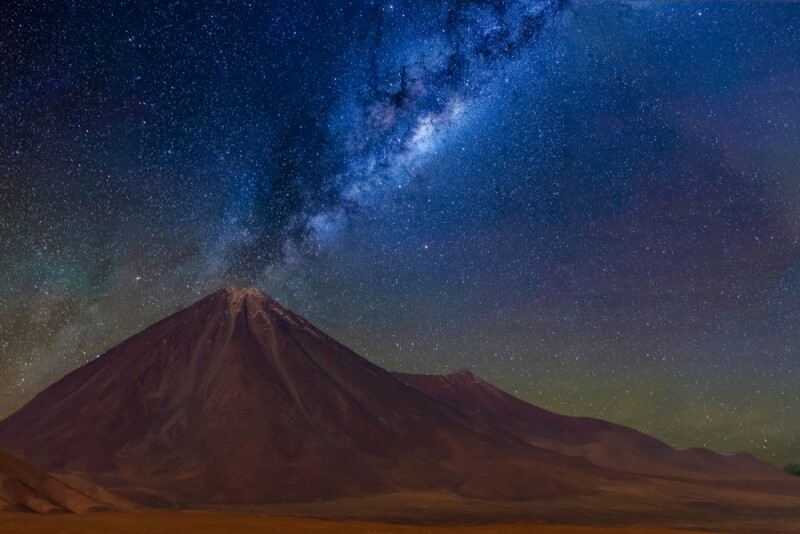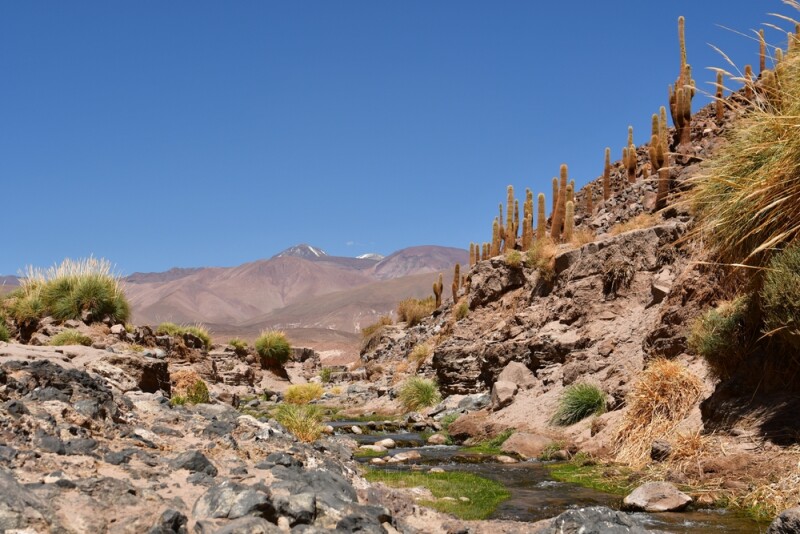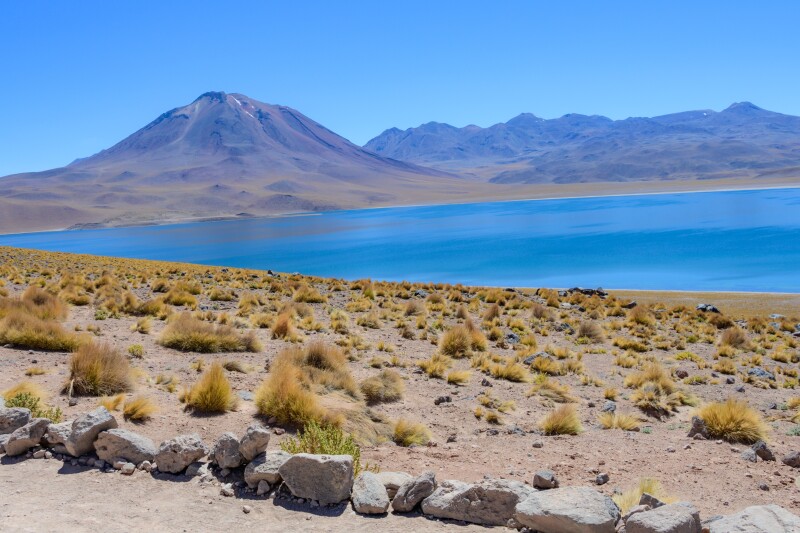Chile is a land of dramatic terrain: The thin country stretches for 2,700 miles along South America’s left side and encompasses some of the earth’s most breathtaking mountain peaks and deserts. The Atacama Desert, in the country’s northern half, covers around 40,000 square miles, even stretching into the neighboring countries of Peru, Bolivia, and Argentina. It’s an awe-inspiring place and also one of the driest regions in the world, only receiving rainfall between two and four times in a century.
From Santiago, it’s about a two-hour flight to the desert city of Calama and then another 90 minutes by car to San Pedro de Atacama. San Pedro is a gateway town that’s the usual base for travelers as they explore, with an abundance of luxury places to stay, such as Our Habitas.
Now’s the hard part: figuring out what to do. Here are seven suggestions to make your trip to the Atacama Desert worthwhile.

While in Salar de Tara, be on the lookout for Monjes de Pacana, giant vertical rocks that look like the silhouette of monks.
Photo by Nataliya Hora/Shutterstock
1. View wildlife at the Salar de Tara
At more than 13,000 feet above sea level, the Salar de Tara high plateau is about a 60-mile drive east of San Pedro de Atacama, near the border point between Bolivia, Argentina, and Chile. The drive is almost as beautiful as the destination, with massive rock structures that could easily be mistaken for Rapa Nui’s moai. Wildlife ranging from flamingos and vicuñas to foxes are abundant in the area. Pack a picnic and relish the scenery, which includes sights of bird life, salt lakes, and the Licancabur, a stratovolcano that sits on the border between Bolivia and Chile and dominates the landscape.

Use the Licancabur volcano to frame the night sky.
Photo by Fotografo de los Andes/Shutterstock
2. Photograph the Milky Way at night
The desert, the world’s highest elevation-wise, has almost no light pollution and gets more than 300 clear nights per year, making it very likely that travelers can have an unobstructed view of the Milky Way and plenty of other stars. Get a better image of the night skies with San Pedro de Atacama Celestial Explorations, an agency that offers access to its large-diameter telescopes on its tours.

The El Tatio geysers are located about 50 miles from San Pedro de Atacama.
Photo by Carlos D Pavletic/Shutterstock
3. Watch a sunrise at the El Tatio geysers
Though temperatures drop below freezing at the El Tatio geyser field, the view is well worth the chill. Get an early-morning start to see steam erupt from the geysers at their most active time of day (usually between 5:30 a.m. and 7:30 a.m.) As sunrise breaks through the clouds, the billowing steam creates a beautiful contrast against the sandy surroundings. —Michaela Trimble

The landscape of Valle de la Luna feels like it’s from another world.
Photo by LouieLea/Shutterstock
4. Feel like you’re on another world at Valle de la Luna
The deep red rocks and massive sand dunes of Valle de la Luna (which means “Moon Valley”) create an otherworldly scene. Peer closely at many of the geological features here, and you will notice deep veins of salt. Stand close (and be quiet) to hear the rhythmic crackling of the salt because of the pressure in the rocks. The valley itself is 22 million years old, and scientists believe the salt was left behind from when an ocean covered this part of Chile. Just a 10-minute drive outside of San Pedro de Atacama, Valle de la Luna is an incredible place to hike, bike, and take in a sunset.

The Church of San Pedro de Atacama is a relic of the Spanish colonial period,
Photo by Pablo Rasero/Shutterstock
5. Explore the colonial-style church of San Pedro de Atacama
The Iglesia de San Pedro de Atacama is a whitewashed adobe church in the center of town. The parish dates back to the 1600s, although the current building was constructed in 1745 and is now considered a national monument. On any given day, you will find individuals stopping for a moment to pray inside. Take a moment to admire the wood detailing on the walls, roof, and the entrance door, as well as the Catholic figures at the front of the altar. —Erin Nave

There are plenty of cacti to see in Guatín.
Photo by Andreas Muth-Hegener/Shutterstock
6. Trek along a rapid river canyon in the desert
There’s a confluence of two rivers in Guatín, about a 25-minute drive north of San Pedro de Atacama. One river is warm and flows from the thermal springs of Puritama; the other, the Purifica, is made up of cold, clear snowmelt from the Andes. Trek alongside this water body and you’ll walk alongside waterfalls, switching back and forth over large rocks. Be on the lookout for different cacti, some of which can grow to more than 20 feet high.

You can find plenty of bird species at the Altiplanic lagoons.
Photo by pauloalberto82/Shutterstock
7. Admire the reflective waters of the Altiplanic Lagoons
A 90-minute drive south of San Pedro de Atacama are the highland lagoons of Miscanti and Miñiques, which are at an altitude of 13,860 feet. Bask in the nature here, including the Andes and two volcanoes that have the same names as the lagoons. Watch as birds like the horned coot and Chilean flamingo swoop down on the reflective waters. This site, as well as the Salar de Tara and Valle de la Luna, is located in the roughly 285-square-mile Los Flamencos National Reserve. —Liz Caskey











